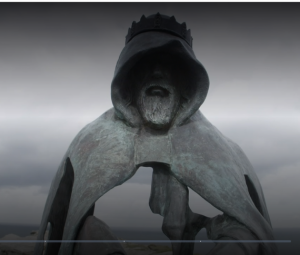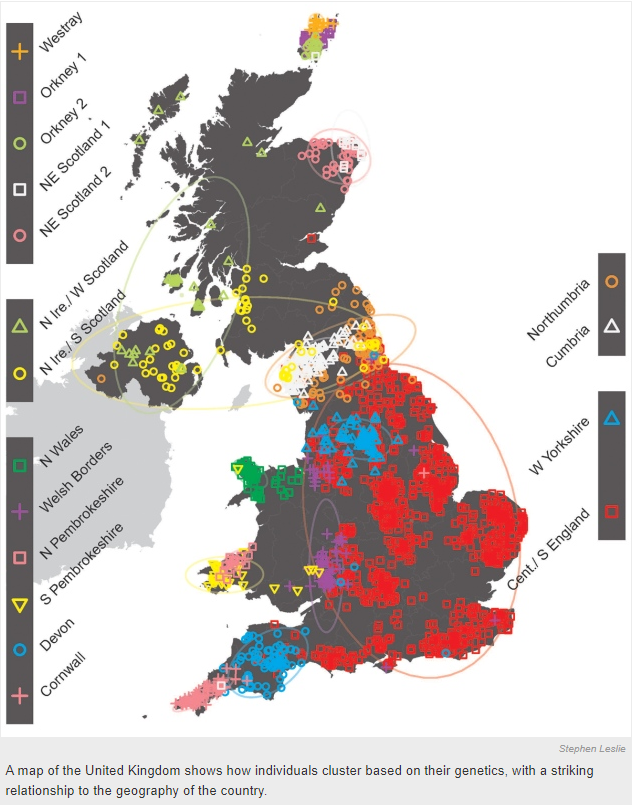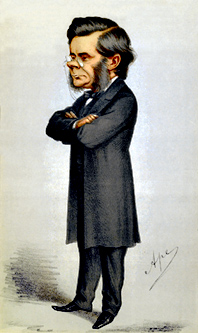Another fascinating program, King Arthur’s Britain: Truth Unearthed
As a boy, I read in children’s books that after the Romans evacuated Britain early in the fifth century the indigenous peoples fell into warlike anarchy and only came together again under the leadership of King Arthur to confront the new invaders from Europe, the Angles, Saxons and Jutes, who had driven the Britons back to the western part of the isles.

Just like the biblical story of King David, I am almost certain that the literary legends are fantasy. Archaeology and DNA, in their current state, appear to leave no room for such scenarios of mass invasions, displacements or a heroic King Arthur rising to save such a day.
Evidence datapoint #1: of the thousands of human skeletons from the period of the fifth and sixth centuries, only 2% have signs of sharp cutting blows that indicate a violent end.
Evidence datapoint #2: widespread and extensive archaeological digs indicate open farming settlements, not fortresses.
Evidence datapoint #3: Jewellery of a Saxon cruciform with a skeleton was long assumed to have been an indicator the person was a Saxon; but new x-ray technology applied to such jewellery shows that it was overlaid with a glass-based enamel that was characteristic of the crafts of the Britons and nowhere found in Europe. It thus appears that such jewellery points to Saxon influence of the design upon the crafts of the native Britons. We cannot assume that the Saxons displaced the Britons in the east.
Evidence datapoint #4: Ancient DNA tests show that some skeletons of the period were the products of intermarriage of Saxons and Britons.
Evidence datapoint #5: Modern DNA tests show a homogeneity of DNA mix among the population of central and western England; this area experienced the most concentrated Roman settlement and was easily traversable through Roman roads here. Other parts of the British Isles show less integrated DNA, suggesting that over the centuries these areas (in the west and south-west) integrated less with European settlers. The thorough mix of DNA in the central and east parts of England demonstrate an integration of populations, of Angles and Saxons with the Britons, and not a replacement of one population by the other.

Evidence datapoint #6: Pottery finds point to Britons (who had a major centre at Tintagel) were trading extensively by sea with Spain, North Africa, through to Anatolia or where modern Turkey is, all through the Byzantine era; meanwhile the eastern part of Britain was trading most with northern and north-western Europe, the Scandinavian and north European areas from where they had originated.
Conclusion: There were no population displacements with the arrival of the Angles, Saxons and Jutes. Rather, these newcomers probably set up in their self-contained communities at first but over time came to integrate with the indigenous population. It was more like the settlement of America, Italian Americans, German Americans, Black Americans, each coming in in their own “waves”.
There is no evidence of breakdown into violent anarchy. The two sides of Britain, west and east, appear to have been quite prosperous regions. There is even evidence of literacy among them. There was no scenario that fits the glorious, superhuman tales of King Arthur, happily.
A monk, Gilgal, from the supposed time of King Arthur, writes diatribes against the sins of the Britons and how the Saxon invasions were God’s punishment on them, but he makes no mention of Arthur and we have no way of testing his image of the times. He appears more devoted to writing “godly polemics”.
Geoffrey of Monmouth, our first recorder of King Arthur’s exploits, wrote in the twelfth century. Our material evidence, clay, rock and DNA, suggests his history is fantasy.
The question to ask is what was it about Geoffrey’s day that led him to write about a saviour king in troubled times.

Scott, Kenny. 2018. King Arthur’s Britain: Truth Unearthed. BBC. https://www.sbs.com.au/ondemand/video/1419920963667/king-arthurs-britain-truth-unearthed. [Presented by Dr Alice Roberts]
Callaway, Ewen. 2015. “Uk Mapped Out by Genetic Ancestry.” Nature News. Accessed May 18, 2020. https://doi.org/10.1038/nature.2015.17136.
Leslie, Stephen, Bruce Winney, Garrett Hellenthal, Dan Davison, Abdelhamid Boumertit, Tammy Day, Katarzyna Hutnik, et al. 2015. “The Fine-Scale Genetic Structure of the British Population.” Nature 519 (7543): 309–14. https://doi.org/10.1038/nature14230.


